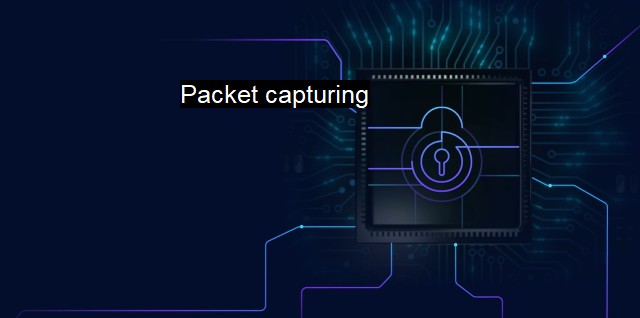What is Packet capturing?
The Importance of Packet Capturing in Cybersecurity: Merging Network Traffic Monitoring & Threat Detection
Packet capturing, often also referred to as packet sniffing, is a key component of network troubleshooting and analysis tools that is commonly utilized within the realms of cybersecurity and antivirus defense. The concept essentially involves the interception of data packets that are being transferred over a network. While this may sound rather nefarious on its face, its purpose extends well beyond the unauthorized seizure of information for malicious intent.At its core, a packet in this context refers to the formatted unit of data that is the foundation for networks and network transmissions. They form the basic building blocks of how users send and receive data online, comprising chunks of data such as the source IP address, destination IP address, payload content, and other relevant metadata.
Packet capturing involves the logging of these details from each packet, monitoring transfer activities, and diagnosing potential issues or threats. It is, therefore, a central part of maintaining healthy communication across a network, keeping it secure and maximizing its efficiency.
From a cybersecurity standpoint, packet capturing plays a wide array of roles. By capturing and analyzing these data packets, cybersecurity teams can establish a broad understanding of a network's typical traffic patterns. It allows them to pinpoint anomalies which could symbolize a potential security threat, ranging from a straightforward denial-of-service (DoS) attack to more sophisticated intrusion incidents. packet sniffing also offers insights into common operational issues such as bottlenecks, helping improve network performance which alongside security, forms a crucial objective of IT management.
Of particular interest within the realm of cybersecurity is the details contained within these data packets. By scrutinizing the trace files or logs consisting thereof, an analyst can gain insights into aspects such as the type of protocol being used, the external and internal IP addresses involved, the ports through which the communication is effected, and the payload data itself.
The manipulation of packet capturing forms the backbone of multiple Black Hat (malicious) practices with serious cybersecurity implications, such as man-in-the-middle (MITM) attacks or other spying activities. These operations are often geared toward unauthorized data acquisition or interruption or control of a network's communication flows. awareness of these threats makes capturing an integral part of designing countermeasures implemented in a network, enabling manipulation detection and thus idiomatic "fighting fire with fire."
That's where antivirus systems step in since packet capturing becomes one modality through which they provide security support. The antivirus software not only defends a system from harmful viruses present in files but also oversees and governs network operations. By continuously monitoring packets, such software can spot and act on suspicious activities at a very granular level. The value of a healthy network is inestimable - and packet sniffing proves an indispensable tool in maintaining it.
Should an antivirus system identify a package transmitting a known malicious command or a packet pattern that matches known attack vectors, the traffic could be blocked or quarantined for further scrutiny. Whereas firewalls engender a network’s first defense layer, packet capturing contributes to its deeper, consequent layers, allowing for an intricately multi-faceted security system.
Packet capturing ultimately provides a crucial visibility level into all areas of a network - the good and the bad. With it, security and IT professionals have the ability to delve into network events at the micro level, aligning diagnostics, damage control, and prevention closely with the actual data flow rather than only abstract interpretations of it. This kind of depth and clarity is important for a concise understanding of a network, empowering those in charge of protecting it with crucial investigative tools.
Packet capturing forms an essential part of the cybersecurity landscape, playing a vital role in efficient network management and providing strong of lines of defense against potential threats. From detecting irregular network behaviors to shielding sensitive information and maintaining efficient traffic flow, packet capturing stands as a highly versatile tool and source of valuable actionable data. Its importance is magnified with the constant evolution of network technology and continuously emerging cybersecurity threats.

Packet capturing FAQs
What is packet capturing?
Packet capturing is a technique used to intercept and log network traffic as it travels through a network. It involves capturing and analyzing data packets to gain insight into network activity.How is packet capturing used in cybersecurity?
Packet capturing is used in cybersecurity to monitor and analyze network traffic for security threats. It can help identify and mitigate attacks, such as malware infections, phishing attempts, and unauthorized access attempts.What tools are commonly used for packet capturing?
Wireshark and tcpdump are commonly used tools for packet capturing. Both are open-source, free tools that can capture and analyze network traffic in real-time.Is packet capturing legal?
Packet capturing is legal in most cases when it is done for legitimate purposes, such as network troubleshooting or cybersecurity. However, it can be illegal when used to intercept and monitor private communications without consent. It's important to check local laws and regulations before conducting any packet capturing activities.| | A | | | B | | | C | | | D | | | E | | | F | | | G | | | H | | | I | | | J | | | K | | | L | | | M | |
| | N | | | O | | | P | | | Q | | | R | | | S | | | T | | | U | | | V | | | W | | | X | | | Y | | | Z | |
| | 1 | | | 2 | | | 3 | | | 4 | | | 7 | | | 8 | | |||||||